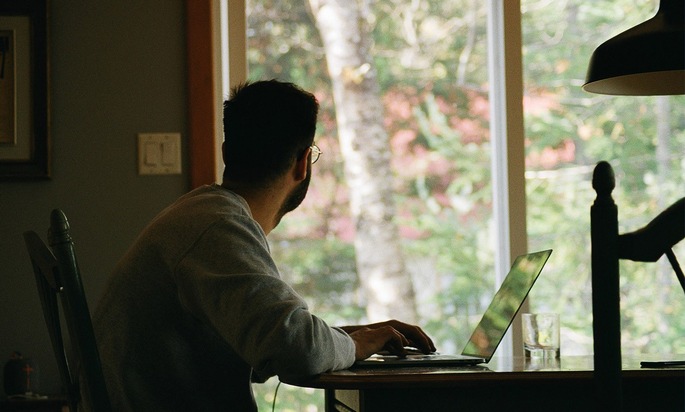BLOGPOST: Loneliness working from home: How the pandemic has changed communication
More than a year into the COVID-19 pandemic and numerous months spent in lockdown, working from home has become the new norm for many employees. Such a significant change is going to have a psychological impact and a study conducted by BARMER and the University of St. Gallen has highlighted the effects of the digital working world on health and productivity. Principal investigator and health researcher Stephan Böhm provides insights into its results and reveals specific communication tips for those working from home.
Working from home is both a blessing and a curse. Even as employees benefit from their newfound freedom, no longer having to commute and with productivity increasing, they nevertheless experience conflicts between their family and career, are getting too little exercise and suffer from loneliness.
After the first surveys appeared in social health@work during the summer of 2020, this second set of study results was able to draw conclusions about how working from home effects people over a longer period of time. Our insights show the potentially dramatic results working remotely can have on the wellbeing of employees when it is handled incorrectly.
How the pandemic has changed communication
Because lockdowns, working from home and video conferences go hand in hand, the results below of the study should come as no surprise to anyone teleworking day after day.
The number of video calls made by employees working remotely has risen 46 per cent since the middle of 2020, while face-to-face conversations took place 28 per cent less frequently. There have been more telephone calls too, with growth from 22.5 to 25.6 per cent of total communication time observed. Even employees not working remotely increased their videoconferencing use, from an initial figure of 2.9 per cent to 4.8 per cent now. There was less change in this group for communication with email and calling on the telephone. While the pandemic has changed the way we communicate with each other, and this can be seen every day, what impact is this change having on our health?
When working from home leads to isolation
Digital teleworking and the spatial distance between employees associated therewith is creating unprecedented challenges – both in new work processes and social relationships. Unless these challenges are overcome, one area in particular of our wellbeing may be put at risk: social health. The ability to interact with others, form meaningful relationships, and the ability to adjust and adapt to different social situations are aspects of our health that had not been previously explored fully.
Colleagues are among the most important social contacts in the lives of many employees. As video conferences largely supplanted daily personal contact with staff, spatial isolation has quickly led to social differentiation: The social health@work study found almost one in four teleworking employees (23.5 per cent) feeling isolated. Among those not working remotely, the figure fell to one in five (19.5 per cent).
Working together and always being able to rely on support also makes the most stressful work days more tolerable. However, 18.3 per cent of those surveyed felt alone working from home, while 32.5 per cent altogether mentioned having lost a sense of community. The study also indicated that the problem could get worse over time. Compared to the summer of 2020, the feeling amongst teleworkers of belonging to a team fell by three per cent. This is a challenge that has become ever more imperative to overcome with the third lockdown and voluntary decisions by employees to work from home.
Five communication tips for working from home
- The right choice of media: Facial expressions and gestures are factors playing an important role in communication. Without them, many messages can be misunderstood. Therefore, you should make a very conscious decision about the topics that can be discussed and the media for discussing them. Most of the time, reaching for the telephone or even sending an email will suffice for unproblematic conversations. But if the issue is more complicated or emotional, video conferencing is the best choice. Nevertheless, be aware that facial expressions and gestures are restricted even with this media and to some extent can be affected by time delays. Therefore, a face-to-face conversation may be necessary for some issues.
- Consciously change the media: Video conferences can put people under pressure. Participants feel like they are being watched during the conversation and are continuously confronted with their own reflections. Wherever possible, carry out conversations also over the telephone. Another advantage of talking on the telephone is that you can move around freely and stand up if you want. This lets you increase the amount of movement, something that could be improved a lot of the time when you are teleworking.
- Promote a sense of community: People become lonely when they have the impression of no longer belonging to a group. It makes no difference whether they are managers or staff. Take the initiative, bring all of the team members together and have regular work-related conversations. Virtual lunches and online game evenings are possibilities.
- Stay in touch: In the digital world, keeping up contacts with colleagues becomes particularly difficult. Whether between meetings, at the start of the day or after a strenuous week, just call your favourite colleagues. Having a private conversation helps regain a bit of normality.
- Taking a breather: There are days when neither a video call nor a telephone conversation will do anything to allay that feeling of isolation. When such situations arise, decide upon the context in which meeting up with colleagues would be possible while complying with all necessary safety measures. Examples include for a walk and doing physical exercise outdoors.
About the author: Stephan Böhm is Associate Professor for Diversity Management and Leadership at the University of St. Gallen and Director of the Centre for Disability and Integration. He is currently examining the correlation between digitalisation, new ways of working and the health of employees. He works as a trainer and consultant for organisations in all industries, whom he advises in management issues such as diversity, change and relationships between management and staff.
This article was originally posted in our blog:
This blog is published by news aktuell, a subsidiary of dpa Deutsche Presse-Agentur.

